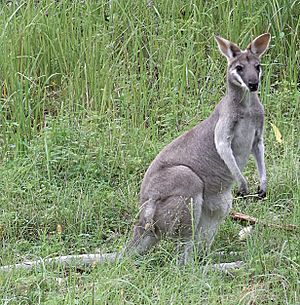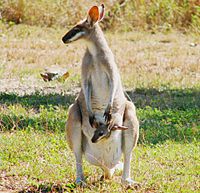Whiptail wallaby facts for kids
Quick facts for kids Whiptail wallaby |
|
|---|---|
 |
|
| Conservation status | |
| Scientific classification | |
| Genus: |
Macropus
|
| Species: |
parryi
|
 |
|
| Whiptail wallaby range | |
The whiptail wallaby (Macropus parryi) is also known as the pretty-faced wallaby. It is a type of wallaby that lives in eastern Australia. You can find them from Cooktown in Queensland down to Grafton in New South Wales. They are quite common in these areas.
Contents
What They Look Like
Whiptail wallabies have lighter fur than other wallabies. They have a white stripe under their faces. Their muzzles are covered in chocolate-brown fur. Their chests are black and white. The rest of their fur is grey to brown.
Male whiptail wallabies weigh from 14 to 26 kg (31 to 57 lb). They stand from 70 to 93 cm (28 to 37 in) tall. Females are smaller. They weigh from 7 to 15 kg (15 to 33 lb). They stand from 65 to 75 cm (26 to 30 in) tall.
Where They Live and What They Eat
The whiptail wallaby lives in grasslands and woodlands. They especially like hills or slopes. They mostly eat grass. In grasslands, they often eat kangaroo grass. They also eat other plants called monocots that grow near creeks.
Whiptail wallabies are mostly active during the day. They are busy in the morning and late afternoon. Sometimes, they are also active at night.
How They Live Together
Whiptail wallabies are very social animals. They sometimes gather in groups called "mobs" with up to 50 wallabies. They live in an area up to 110 hectares (270 acres) wide. The mob usually comes together in the afternoon to eat.
Some groups' living areas might overlap. Members of the mob take turns resting and watching for danger. Mobs include wallabies of all ages and both sexes all year. However, not all members of a mob are together at the same time. Mobs often split into smaller groups of fewer than 10 animals. These smaller groups change all the time.
Whiptail wallaby mobs have a pecking order. This order is decided by a gentle "pawing" action. They might also pull grass. Whiptail wallabies will cough to show they are giving up. These actions help decide which males can mate with females.
Reproduction and Life Cycle
The strongest males are usually the ones that mate with females. A male will walk through a group of females. He sniffs them and tastes their urine to see if they are ready to have babies. When a male finds a female who is almost ready, he stays with her. But a stronger male might take his place before she is fully ready. A female whiptail wallaby is ready to have babies for only about 42 days.
Baby wallabies are called joeys. They stay in their mothers' pouches for the first nine months. After they leave the pouch, they stay with their mothers for up to 18 months. Whiptail joeys always follow their mothers. They do not hide in plants. Younger male wallabies sometimes leave their family groups.
Their Status in the Wild
The whiptail wallaby lives in many protected areas. There are no big threats to this animal right now. However, people clearing land has probably caused them to lose some of their homes. This has also made their living area smaller in the southern part of their range.
See also
 In Spanish: Macropus parryi para niños
In Spanish: Macropus parryi para niños




